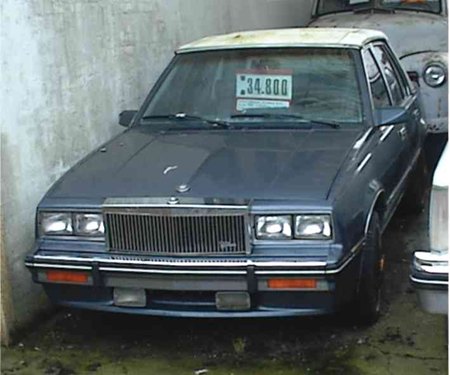General Motors Death Watch 116: Groundhog Day
GM circa 2007: bad investments and expensive labor contracts; excess capacity and crushing debt; a surfeit of brands and products. It’s also GM circa 1910, 1920, 1973, 1980, 1991 and 1998. In fact, wandering through GM’s history is like watching an endless loop of "Groundhog Day." Clearly, The General doesn’t share Phil Conners’ ability to learn from its mistakes. Can there ever be a happy ending for The General?
Automotive pioneer Billy Durant created General Motors by assembling a group of carmakers in the 1900’s. By 1910, his hands-off management style and buying spree left his creation high and dry. Durant’s backers jettisoned the conglomerate’s founding father. Bankers refinanced GM. Durant regained control in 1915 and restarted the cycle. In 1920, GM was broke, Durant was canned and GM got off the treadmill.
Under the watchful eye of Alfred P. Sloan, GM became an industrial juggernaut. The domestic automaker carved out a 40 to 50 share of the U.S. car market and never reported an annual loss (until 1980). But there was a dark side to GM’s fifty plus years of dominance: the company became fat, dumb and lazy.
The causes of GM’s cyclical mismanagement are rooted in the company’s– indeed Detroit’s– Golden Age. During the boom times, GM was a conglomeration of enormous semi-independent enterprises, all contributing to one big bank account marked “GM profits.” This structure worked well enough in an expanding market with few competitors.
Despite the logo on their paychecks, the people within this corporate amalgam weren’t loyal to GM. They worked for Buick, or Fisher Body, or Delco, etc. GM gradually evolved into a maze of deeply entrenched hierarchies and fiercely competitive fiefdoms. Workers and management attended to their own interests or the interests of their unit, rather than GM as a whole. Any attempt at altering the status quo was greeted with “what’s in it for me/us?” rather than “Is it good for GM”?
The resulting bureaucracy lacked speed, strategy or shared motivation.
The ‘70’s oil shocks gave GM its first fish slap in fifty years. As GM’s lineup of gas guzzlers and uncompetitive small cars lost out to upstart foreigners, the company’s fortunes began a worrying decline.
In GM’s ossified corporate culture, only one recipe for “change” could satisfy all factions. Ignore problems (protect the status quo), fire workers (reassure Wall Street) and tout the Next Big Thing (deflect everyone’s attention from This Big Mess).
So The General laid off workers, demanded more from remaining employees, built more barges and waited for oil prices to drop. By the mid ‘70's, the imports had gained a secure foothold in GM’s backyard. To stop the rot, The General closed more plants, laid off more workers and declared that its new downsized FWD cars would ‘push Japan back into the sea.’
Faced with GM’s Byzantine bureaucracy, top management tried to foster change through big initiatives. This pattern hit its zenith when Roger Smith (of "Roger and Me" fame) led GM during the '80's. After a massive reorganization in 1984, Smith dismissed thousands of workers and began a buying spree of epic proportions.
GM’s CEO spent an estimated $40b on a laundry list of fashionable solutions distractions: NUMMI (New United Motor Manufacturing Inc.), EDS (Electronic Data Systems Corporation), Hughes Aircraft and more. Meanwhile, GM proclaimed that vehicles like the Saturn, GM-10 midsize cars and the Impact EV would reverse their declining fortunes.
GM’s culture ignored the benefits of these innovations. The Toyota-style production techniques learned at NUMMI and the union-friendly ideas implemented at Saturn’s Spring Hill plant never made it outside the factory gates. GM management remained impervious to EDS’ can-do culture. Saturn devolved into another badge-engineered GM platform brand.
During the SUV-based profits blip, GM couldn’t resist the old urge to bulk up, adding Saab, Hummer, Daewoo and parts of Isuzu, Suzuki, Subaru and FIAT to the portfolio. Now, once again, they’ve been caught up the creek without a small car shaped paddle. Once again, the next Beta-Zeta-Gamma-GMT900 will save them. And again, GM has resorted to layoffs (this time with payoffs).
The net result is GM 2007 looks an awful lot like GM 1910 (or 1920 or 1973). By not rationalizing its management structure, brands, product development process, capital outlays and labor contracts, GM has come full circle. Only now it has a 23 percent market share instead of 50 percent. And it’s running out of time and money.
Ironically, Durant’s reaction to the GM of 1910 still seems relevant today, “I saw cherished ideas laid aside for future actions, never to be revived. Opportunities that should have been taken care of with quickness and decision were not considered. The things that counted so much in the past, which gave General Motors its unique and powerful position were subordinated to liquidate and pay.”
How the mighty have fallen.
More by Eric Stepans
Latest Car Reviews
Read moreLatest Product Reviews
Read moreRecent Comments
- Safeblonde MSRP and dealer markup are two different things. That price is a fiction.
- Del Varner Does anyone have a means to bypass the automobile data collection?
- Kjhkjlhkjhkljh kljhjkhjklhkjh two cam sensors p0024, a cam solenoid, 2 out of pocket TSB trans flushes for the pos chevy transmission 8l45 under recall lawsuit , Tsb 18-NA-355, 2 temperature sensors and a ##ing wireing harness because the dealer after the 2nd visit said the could not find out why the odb2 port and usb ports kept blowing fuses.This 2018 truck is my last domestic vehicle, the last good domestic i had was a 1969 straight 6 chevy nova with a Offenhauserintake and a 4 barrel. Only buying toyota going forward.
- 3-On-The-Tree I have a 2009 C6 Corvette LS3 and the only major repair that I have done on it was replace the radiator. Besides usual plugs, wires oil etc. And yes those tires are expensive as well.
- 28-Cars-Later We had a red 2003 with less than 100 miles in late 2004/5ish and kept it till the end AFAIK. I do recall being told we had about $28,000 in at the time (about $43,6 in 2023 Clown World Bux). I don't ever recall anyone retail even looking at it, and it lived in the showroom/garage."It's an automatic that just had the linkage repaired and upgraded"This really doesn't bode well. Maybe there's a upgrade I'm simply not aware of so one could tune the 3rd Gen LM4 for higher power but messing with it isn't making me smile because now I know its no longer factory or somehow it broke and with such low miles I'm equally concerned.


































Comments
Join the conversation
From the Lutz interview: "We'll decide on our rear-drive cars when the government decides on CO(-2) levels and CAFE regulations," Lutz said, adding that limiting CO(-2) would increase mileage, too." Wow, what a smart business man he is, eh? You cannot put a development program on "pause". These things aren't DVD players. One of Detroit's many problems is start-stop-start-stop development. The executives think you can just turn the development process on and off like a light switch. Doesn't work that way. I can imagine that the latest political developments have Honda and Toyota management also going back to their desks and working out various product contingency plans, but you aren't going to see those guys shoot their mouths off in some lame attempt to pressure the government into making a decision. The idea that you can just sit on your hands and make mad faces untill the government makes up it's mind is foolishness. In a democracy the "goverment" can change it's mind at any time. There is no firm plan for anything, and he who waits for the final plan is a fool.
P.S. The organizational structure of GM today looks nothing like it did 50 years. Those who think GM's current problems are the result of an outdated structure have not studied the structural history of GM at all. GM in the 1950s consistent of highly independent divisions, most of which made cars, but some of which made components (AC-Delco, Rochester Products, etc.), some made trains, some made big trucks, some made large diesel engines for sale to the commercial market, some made tanks, some made appliances (Frigidaire). GM corporate was basically oversight, advanced R&D labs and finace. The individual divisions had their own designs (sometimes sharing platform elements), their own engines, their own factories, their own marketing, their own dealer networks, their own everything. GM today is a completely top-down centralized organization which looks nothing like the 1950s GM. It has been rationalized and neutered. No wonder it now lacks the flexibility to compete.